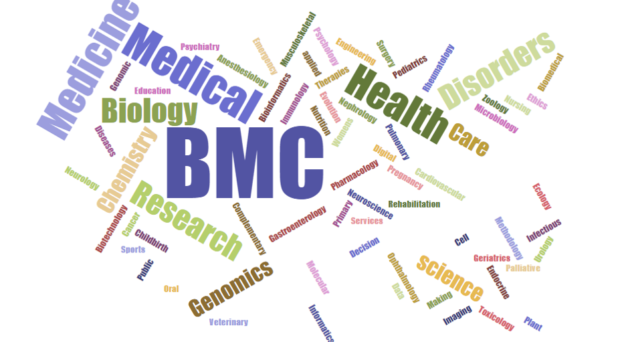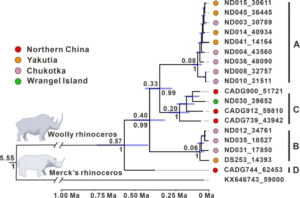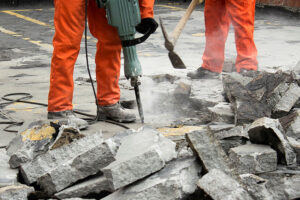
BMC Ecology and Evolution – Ancient mitogenomes reveal a high maternal genetic diversity of Pleistocene woolly rhinoceros in Northern China

This study brings us back in time to the Middle to Late Pleistocene (about 0.46 − 0.012 million years ago, Ma), when our far away ancestors were living alongside the woolly rhinoceros (Coelodonta antiquitatis), an extinct rhino of the genus Coelodonta that was particularly well adapted to cold climates and widely distributed in the Northern Hemisphere. Traces of their cohabitation has been found in caves such as Lascaux and Chauvet but sadly the phylogenetic trees of the woolly rhinoceros was not included!
Investigation of rhinoceros fossils previously uncovered in Northern China and Siberia led to the hypothesis that the Chinese fossils are the descendants of the Siberian relatives. The increasing availability of ancient DNA samples has led to a refinement of the phylogeny of the Rhinocerotidae family and the woolly rhinoceros now appears to be more closely related to the Sumatran rhinoceros than any other extant rhinoceros.
The authors generated four mitogenomes from 16 Late Pleistocene woolly rhinoceros in Northern China and carried out a comparison with previously published genomes in order to investigate the maternal lineage of the Chinese woolly rhinoceros. They also calculated the nucleotide diversity of woolly rhinoceros’ specimens from different regions in Asia thus providing insights into the molecular evolution of Chinese woolly rhinoceros and shedding light on of past dispersal events of this extinct rhino. They detected a new early separating maternal clad, deeply divergent, that could represent the first woolly rhinoceros population before its dispersal into Asia. Alternatively, this newly discoverer clade could point to this extinct rhino having evolved in Northern China rather than in Europe! This theory would indeed require further investigation. In any case, these findings highlight Northern China as a possible refugium for Quaternary mammals under pressure of climate and environmental changes and a key evolution center of the Pleistocene woolly rhinoceros.
BMC Genomic Data – Complete genome sequences of Providencia bacteriophages PibeRecoleta, Stilesk and PatoteraRojo
Providencia are gram-negative bacteria commonly associated with nosocomial urinary tract infection, wounds in burn patients and linked to diarrhoea and gastroenteritis. They are naturally resistant to commonly used antibiotics including colistin, the last resort antibiotic for multi-resistant gram-negative bacteria. As such, they are classified as Critical Priority 1 on the World Health Organizations global priority pathogens list requiring further research and development of new antibiotics.

The limitations stated by the authors are that the small number of currently available genomes for Providencia phages is limiting our understanding of them and that more genomes will increase our knowledge and help to develop them as potential biotherapeutics agents in the future.
This data note was submitted as part of the Bacteriophage data notes Collection.
BMC Public Health – Occupational exposure to fine particulate matter in the reinforced concrete production and its association with respiratory symptoms and lung function
Despite the very wide use of reinforced concrete, very little is known about the occupational exposure to fine particulate matter (PM) in concrete production workplace.

This study set out to characterize exposure to PM in a typical workplace for the whole duration of the production cycle in order to quantify the risks of respiratory symptoms and lung function in a cohort of reinforced concrete parts production industry in Almaty, Kazakhstan.
50 personal samples were collected from workers in the factory in the summer of 2023 using portable PM2.5 cyclones and filters. 10 samples at each of the five different locations included: the concrete-mixing unit, the armature shop, the metal working workshop, the molding workshop and finally the office as a control. The workers were also asked to complete a questionnaire about their working history, respiratory symptoms which was followed by a lung function test.
The highest PM2.5 concentrations were found in the concrete-mixing unit (median 1180 µg/m3), followed by metalworking (510 µg/m3), armature workshop (375 µg/m3) and molding site (245 µg/m3), different from the concentrations in the office (29.5 µg/m3).
The authors concluded that mixing concrete and metalworks are the steps that pose the greatest risk for worker’s health due to the higher exposure. It is due to the exposure to aerosol via inhalation which are adversely affecting respiratory health by causing more respiratory symptoms, independently of smoking and past respiratory diagnoses. Therefore wider use if PPE and exposure control measures should be put in place in reinforced concrete parts production in order to preserve workers’ health.
BMC Medical Informatics and Decision Making – Combining unsupervised, supervised and rule-based learning: the case of detecting patient allergies in electronic health records
Electronic health records (EHRs) have a huge potential to improve clinical decision support and to help delivering precision medicine. This is however limited by the rule-based and machine learning-based approaches used for natural language processing (NLP) in healthcare today and their shortcomings.

This paper describes a novel method NLP that implements unsupervised learning of word embeddings and allows for the clinical language to be automatically learnt with only minimal manual feature engineering and tagging required from clinical experts. This pipeline enables a gradual refinement of the data in a transparent way and the predictions are interpretable, a key factor for healthcare.
The method was put to the test using real EHR dataset and evaluating its performance at a classification task which in this case was used to detect patient’s allergies compared to a range of common supervised learning algorithms. The new, combined method performed much better than the other method evaluated. These promising results suggest that more research should be aimed at exploiting the inherent synergies between unsupervised, supervised, and rule-based paradigms for clinical NLP.
BMC Oral Health – Oral health in an urban slum, Nigeria: residents’ perceptions, practices and care-seeking experiences
A visit to the dentist can easily make the list of the most universally disliked activities. However, despite their unpopularity, these visits are nonetheless essential for buccal hygiene and to avoid complications. In this study, researchers tackle the oral health perceptions, practices and care-seeking experiences of slum residents in Ibadan, Nigeria. Indeed the WHO has recommended inclusion of disadvantaged populations in their new global oral health strategy.

This was an exploratory qualitative study making use of face-to-face-focus group discussions with representative households between September and October 2019.The participants were between 25 and 59 years old. Dental pain was the most commonly reported oral health issue mentioned by the participants and they mostly describes the intensity and severity of the pain. The consequences of these pain were severe sometimes even resulting in the death of the patient!
The study concluded that the residents had preconceived ideas about dental clinics such as them being unaffordable that precluded them from visiting them. Instead they preferred self-care remedies and engaged in sometimes harmful oral health practices. Policymakers would need to take these findings into account in order to provide better education on early dental care as well as available, and affordable oral healthcare to slum residents.
Comments